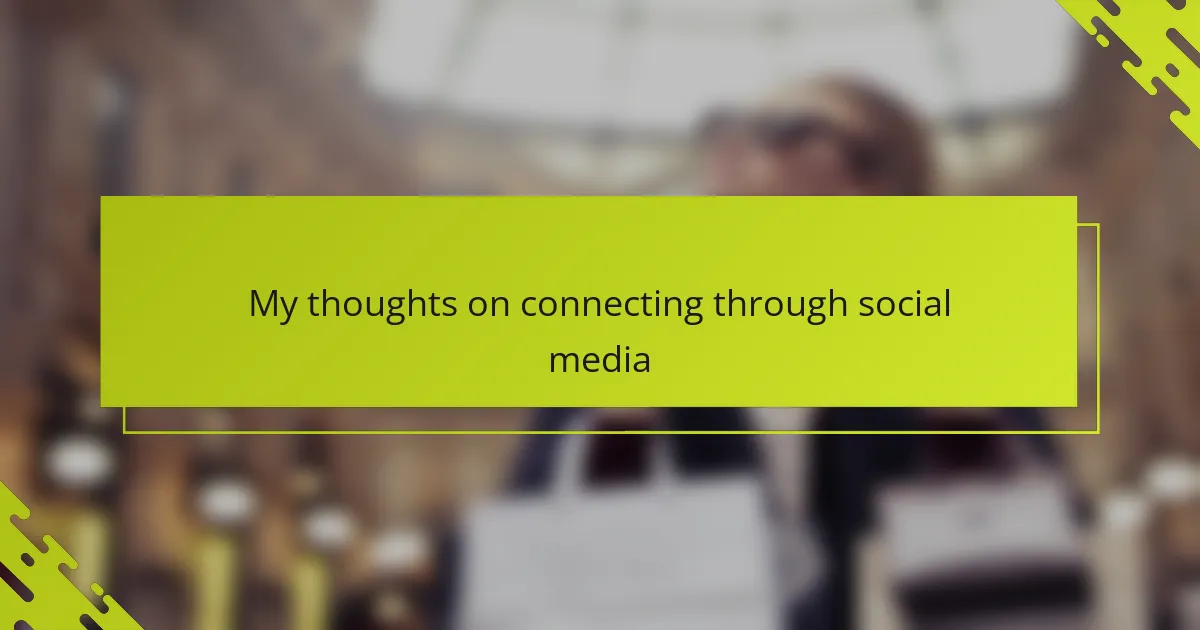Key takeaways
- Social media can foster a sense of community and connection, yet it often presents challenges like negativity and pressure to be perfect.
- Building genuine connections requires intentional engagement, vulnerability, and consistency in interactions.
- Navigating online spaces demands setting boundaries and approaching discussions with kindness to protect emotional well-being.
- Personal storytelling in digital platforms can create deep connections, making online interactions feel more meaningful and supportive.
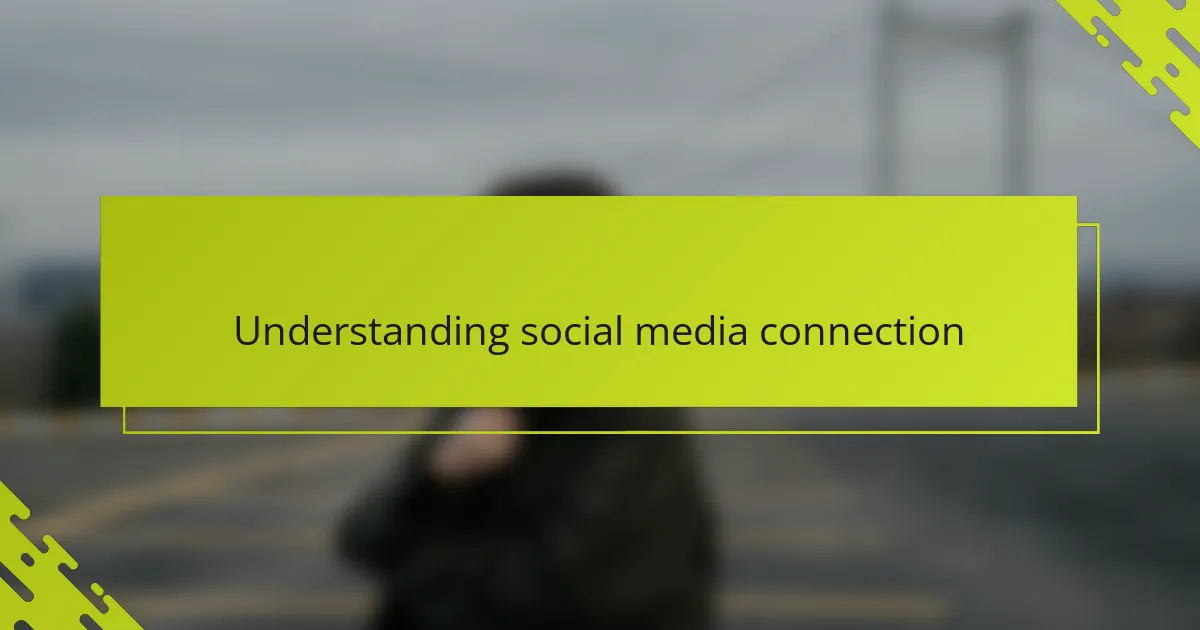
Understanding social media connection
Social media connection often feels like a double-edged sword to me. While it offers immediate access to others, I sometimes wonder if these connections run as deep as face-to-face interactions. Have you ever noticed how a quick like or comment can feel both affirming yet strangely distant?
From my experience, understanding connection on social media means recognizing its unique language—emojis, gifs, and shorthand expressions that carry emotional weight in their own way. It’s fascinating how these small symbols can create a sense of belonging, especially when words feel hard to find.
Yet, I’ve also felt moments of isolation despite being surrounded by notifications. This made me question: Is social media truly connecting us, or are we creating an illusion of togetherness? For me, it’s a balance of celebrating these connections while staying aware of their limitations.

Overview of queer women culture
Queer women culture is vibrant and multifaceted, woven together by shared histories, struggles, and celebrations. From my experience, it’s not just about identity but also about finding spaces—both physical and digital—where authenticity is embraced without judgment. Have you ever felt that rush of relief simply by realizing you’re not alone in your experiences?
What strikes me most is how this culture thrives on creativity and resilience. Whether through art, activism, or everyday conversations, queer women continuously reshape what connection and community mean. Sometimes, these bonds form in the most unexpected places, reminding me that culture is alive and always evolving.
At the heart of queer women culture lies a commitment to visibility and empowerment. I’ve witnessed firsthand how storytelling and shared vulnerability can break down barriers and foster deep understanding. Isn’t that the essence of what makes any community truly strong?
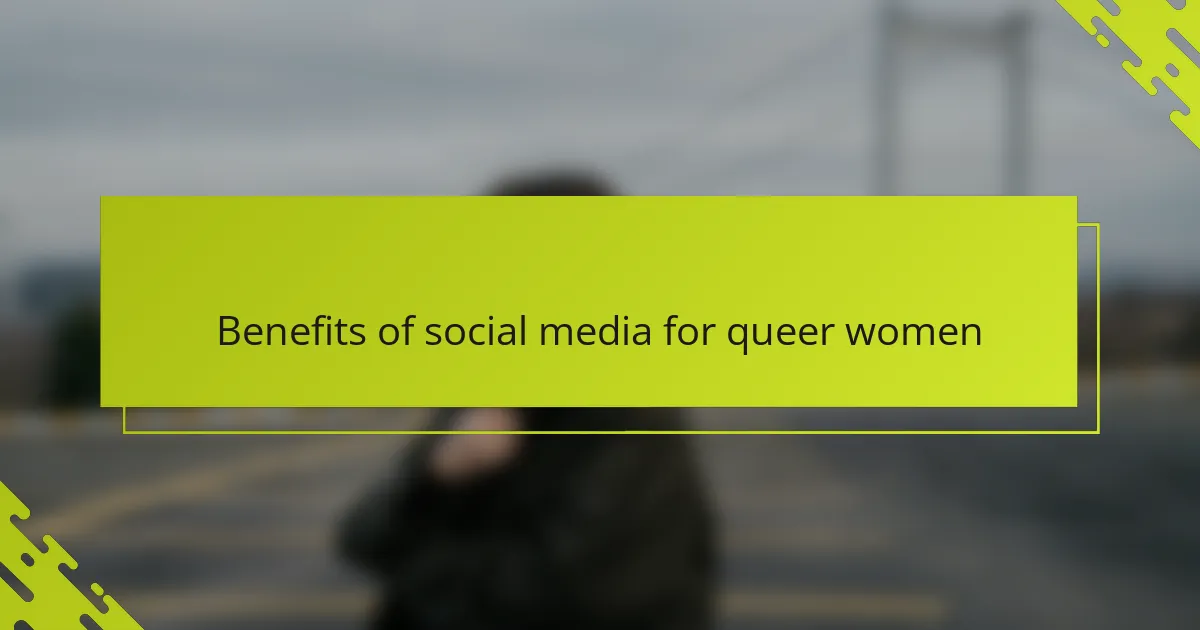
Benefits of social media for queer women
Social media has been a lifeline for me and many queer women in finding community where traditional spaces often fall short. It’s incredible how platforms can bring together people across cities, countries, even continents, creating a sense of solidarity that might otherwise be impossible to find. Have you ever scrolled through a feed and felt instantly less alone because of someone’s story or art reflecting your own experience?
One of the most powerful benefits I’ve noticed is the ability to share and access diverse voices that often go unheard in mainstream media. Through social media, queer women can amplify their stories, challenge stereotypes, and celebrate their identities openly. This kind of visibility doesn’t just build awareness—it creates a mosaic of resilience and pride that feels deeply empowering to witness and take part in.
But beyond connection and visibility, social media also offers a space for education and support that feels uniquely immediate. When I’ve faced questions about identity or needed advice, I’ve found quick, caring responses from folks who understand without judgment. Isn’t having that kind of accessible, empathetic network a game-changer when offline resources can be sparse or inaccessible?
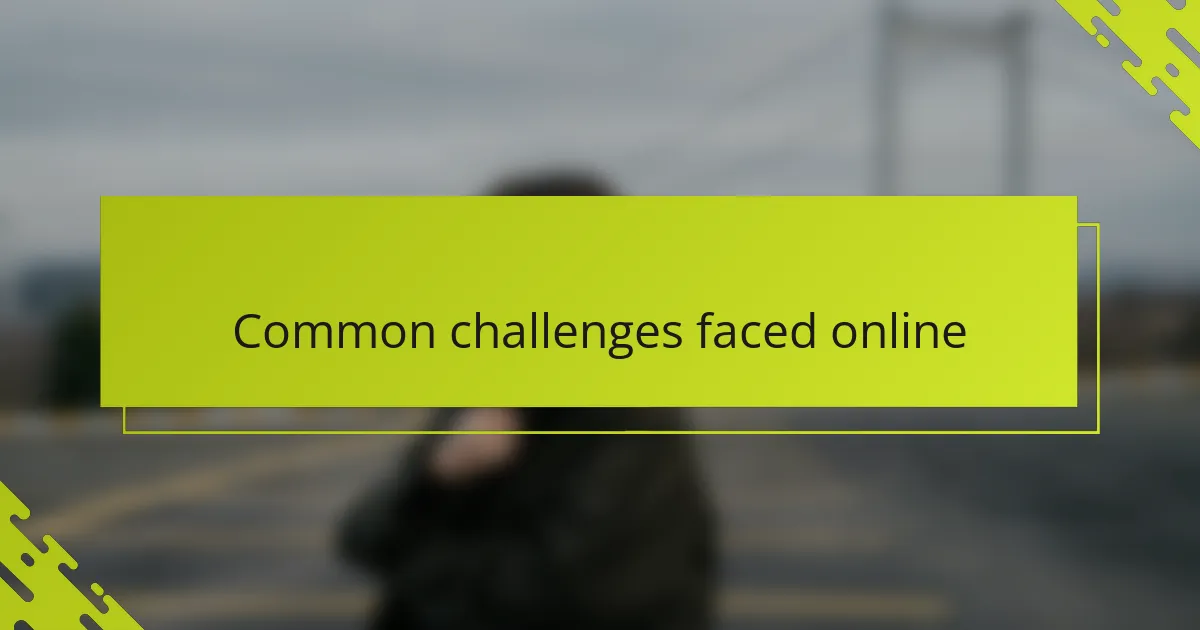
Common challenges faced online
One challenge I often encounter online is the overwhelming presence of negativity. Even within spaces meant to be affirming, harsh comments or misunderstandings can instantly derail a conversation. Have you ever felt hesitant to share something vulnerable because you feared judgment hiding behind a screen?
Another difficulty is the pressure to present a perfect version of ourselves. I’ve noticed that scrolling through carefully curated profiles sometimes leaves me doubting my own authenticity. It makes me wonder—are we connecting with real people or just the highlight reels they choose to show?
Lastly, navigating misinformation and stereotypes can be exhausting. From my experience, it takes constant vigilance to challenge assumptions and educate others, which can feel draining. How do we protect our mental health while still fighting to be seen and understood?
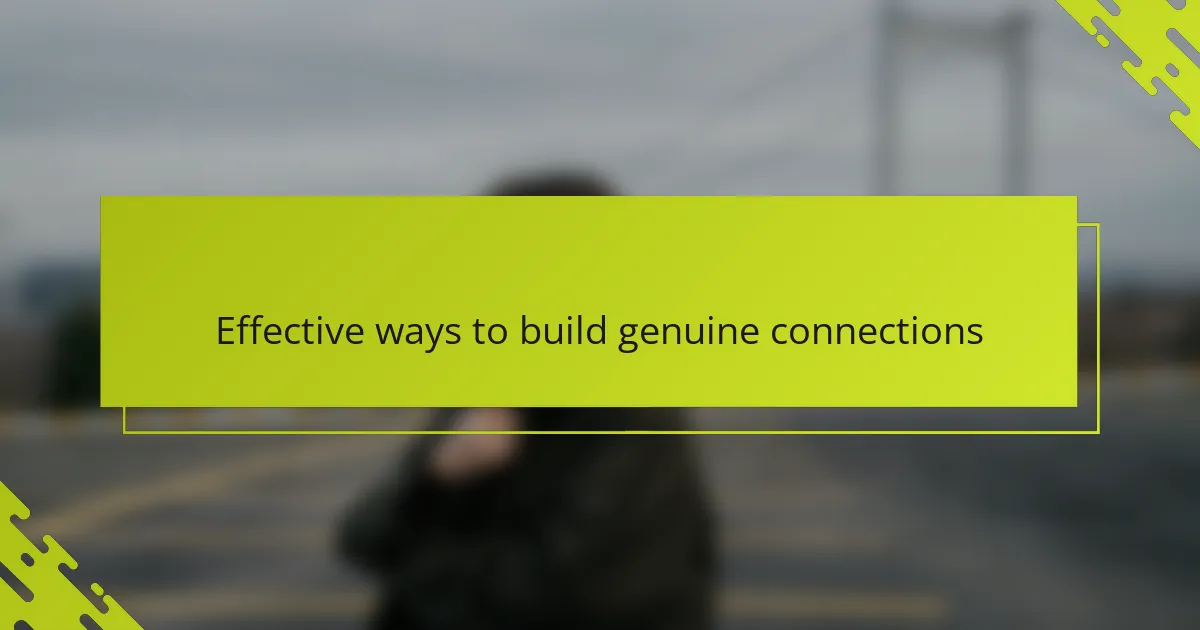
Effective ways to build genuine connections
Building genuine connections on social media, to me, starts with intentionality—choosing to engage beyond surface-level interactions. I’ve found that asking thoughtful questions or sharing small, authentic slices of my life invites others to do the same, creating moments of real exchange instead of just quick reactions. Have you noticed how a meaningful conversation can suddenly shift the tone from fleeting to fulfilling?
Another key aspect is vulnerability. Though it feels risky, opening up about struggles or uncertainties has often deepened my connections more than polished posts ever could. It’s amazing how sharing imperfection can spark empathy and trust, making the digital space feel a bit more human and warm.
At the same time, I’m mindful of consistency. Genuine relationships require ongoing presence—checking in, responding, and showing that people matter beyond one-off comments. It’s not always easy to keep up, but those little efforts have helped me build a network where I feel seen and supported. Do you find that small, steady gestures carry more weight than grand declarations online?

Personal reflections on social media use
Social media often feels like a mirror reflecting both my best and most vulnerable selves. I remember times when a simple message from a stranger who truly ‘gets it’ lifted my spirits in ways I didn’t expect. Have you ever found comfort in the most unlikely online interactions?
At the same time, I sometimes catch myself scrolling endlessly, searching for connection but feeling more fragmented with each swipe. It makes me ask: am I nurturing meaningful bonds, or just filling a quiet space with digital noise? From my experience, being mindful about how and why I engage has made a world of difference in feeling truly connected.
There’s a unique power in sharing personal stories online, especially within queer women communities where lived experiences resonate deeply. Opening up about my journey hasn’t always been easy, but it’s often sparked conversations that remind me we’re not just profiles—we’re real people yearning for understanding. Doesn’t that kind of connection make the virtual feel a bit more like home?
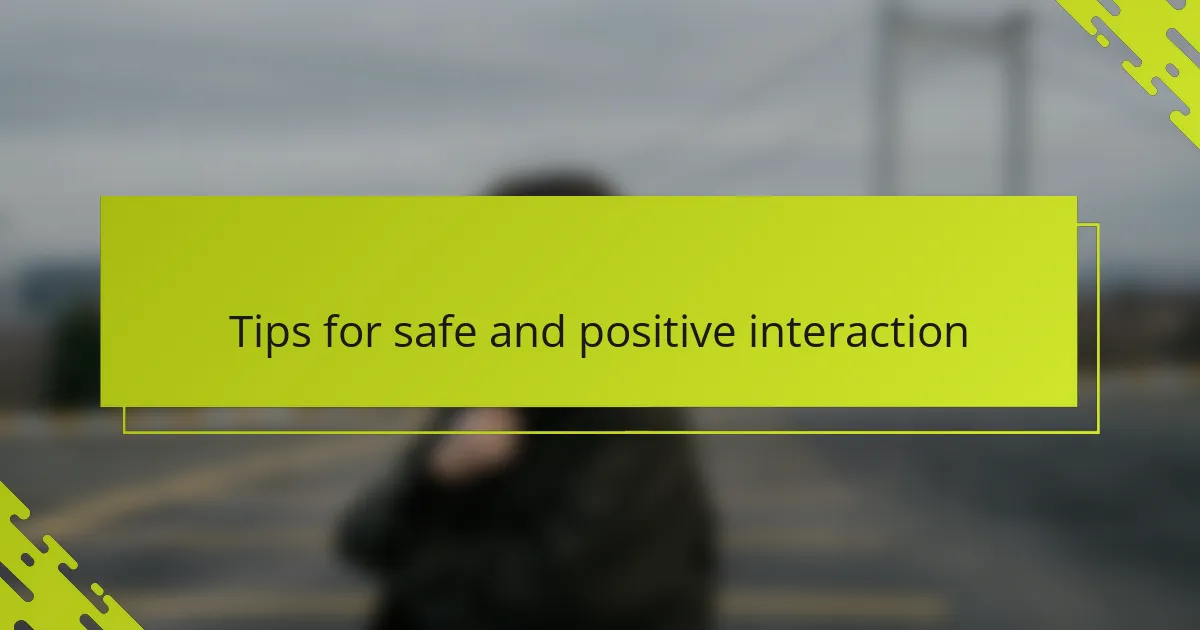
Tips for safe and positive interaction
When I interact online, I’ve learned to set clear boundaries about what I share and with whom. It’s important to protect your emotional space by being selective about the communities you join and the conversations you engage in. Have you ever noticed how stepping back from a tense thread can be as healing as diving into a supportive chat?
I also try to approach interactions with kindness and patience, even when disagreements arise. That gentle attitude often softens misunderstandings and keeps the atmosphere positive. From my experience, responding thoughtfully rather than reacting impulsively helps build connections that feel respectful and genuine.
And here’s something I remind myself often: trust your instincts. If something feels off or unsafe, it’s okay to mute, block, or simply step away. Protecting your well-being online isn’t a sign of weakness but a crucial act of self-care. Have you ever felt relief after cutting ties with a draining digital interaction? I certainly have, and it’s always worth it.
